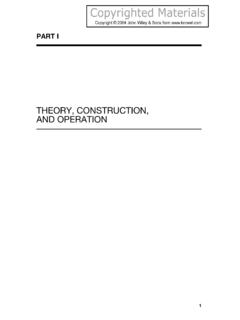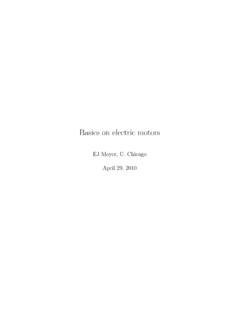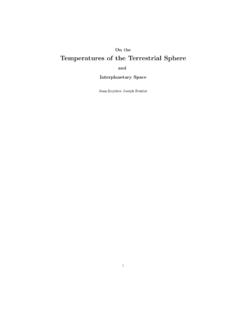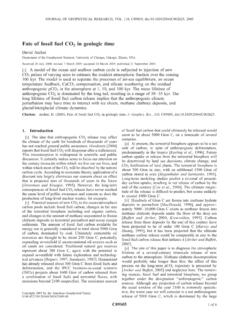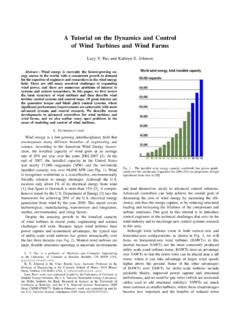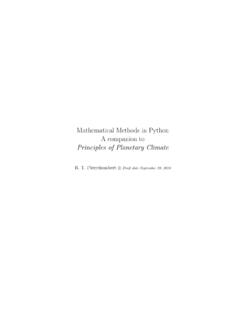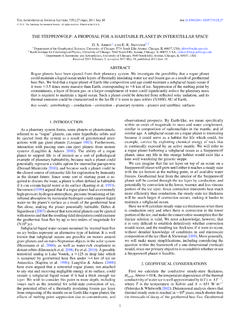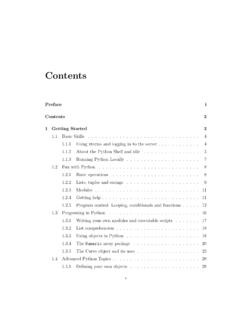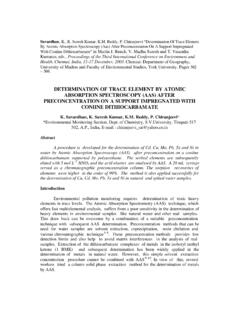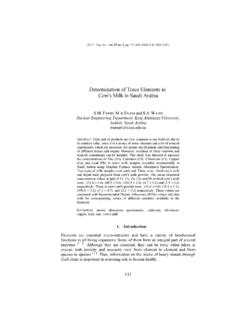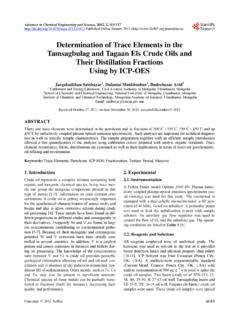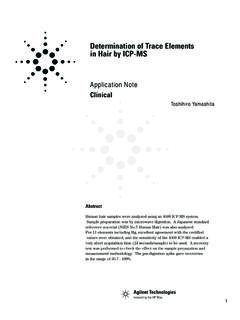Transcription of Determination of trace element mineral/liquid …
1 Geochimica et Cosmochimica Acfa Vol. 53, pp. 31 IS-3130 Copyright 8 1989 Pergamon Press pk. Printed in 0016-7037 + .oO Determination of trace element mineral/liquid partition coefficients in melilite and diopside by ion and electron microprobe techniques S. M. KUEHNER, J. R. LAUGHLIN,* L. GROSSMAN, M. L. JOHNSON,~ and D. S. BURNETT~ Department of the Geophysical Sciences, University of Chicago, Chicago, IL 60637, Department of Chemistry, University of Chicago, Chicago, IL 60637, Department of Geological and Planetary Sciences, California Institute of Technology, Pasadena, CA 9 1125, (Received February 6, 1989; accepted in revisedform September 15, 1989) Abstract-The use of the ion microprobe for quantitative analysis of Sr, Y, Zr, La, Sm, and Yb in melilite and pyroxene is evaluated. Three trace element -doped synthetic glasses of composition Ah, Ak,, and D&AbAn were analyzed by ion microprobe (IMP) using ion yields determined from Coming glass stan- dards.
2 IMP-determined oxide concentrations in the Di2 AbAn glass agree well with electron microprobe (EMP) analyses (to within 6%), but IMP analyses of the melilite glasses deviate from EMP averages by up to 19%. The deviations are due to erroneous Si02 estimates caused by suppression of Si ion intensities by the enhanced concentrations of Ca and Al in the melilite glasses compared to the standards. Thus, in order to determine compositions of melilite, diopside, and glass from subliquidus experiments on each of the three starting compositions, we adopted a new set of ion yields such that IMP analyses of the three starting glasses reproduce the EMP average compositions. Further IMP and EMP comparisons of the subliquidus assemblages show that quantitative analyses of melilite, diopside, and glass can be obtained by IMP that are within 10% of the concentrations obtained by EMP, when ion yields determined from glass starting compositions are used.
3 EMP-IMP comparison of crystal and glass analyses also suggests that a structural matrix effect may result in overestimation of SrO (lo-12%) in melilite by IMP. Comparison of our data for Ak,z and Akw melilite compositions with literature results shows that melilite/liquid D-values for REE3+ determined by IMP decrease with increasing & (Akw: Db = , D Sm = , Dyb = ; Ak12: , , , respectively) while that for Sr (=Eu ) changes only slightly ( to , respectively). Since &, increases with decreasing temperature for all melilite with XAk < , a progressively larger positive Eu anomaly is predicted for melilite as it crystallizes with falling temperature. Our diopside/liquid data are characterized by a large degree of scatter on most interelement correlation plots of apparent partition coefficients. The data cannot be understood in terms of simple models of boundary layer formation but require a complex surface partitioning explanation.
4 Nevertheless, estimates of diopside/liquid D-values are in excellent agreement with literature data. INTRODUCTION EQUILIBRIUM PARTITIONING of trace elements between crys- tals and coexisting liquids has been used extensively to model the chemical evolution of a magma brought about by crystal fractionation processes. In favorable circumstances, differ- ences in whole-rock trace element concentrations between samples from a given magmatic center can be assessed in terms of fractionation of liquidus phase assemblages. Results of these studies may indicate, for example, a history of high pressure crystal fractionation of phases for which there may be no petrographic evidence (SHERATON et al., 1984), or pro- vide evidence for complex partial melting and magma cham- ber processes (LANGMUIR et al., 1977; PANKHURST, 1977). Experimental studies by STOLPER (1982) and STOLPER and PAQUE (1986) show that some Ca-, Al-rich inclusions (CAIs) in carbonaceous chondrites represent closed-system, essentially total-crystallization products of partially molten droplets.
5 With such presumably simple magmatic systems, studying the trace element evolution of the liquid during CA1 solidification should permit a sophisticated level of under- standing of the igneous processes. Alternatively, Type B CAIs originating by processes other than igneous crystallization may also be identifiable. Unlike terrestrial differentiation studies, however, separate aliquots of bulk material produced during successive stages of crystallization inside single Type B inclusions are not available for analysis. The progressive change in liquid composition must instead be inferred by examining trace element zoning profiles within the crystal- lizing phases of the inclusion. In this case, it is necessary not only to understand quantitatively how trace elements are partitioned between crystals and liquid, as in terrestrial stud- ies, but it is also necessary to be able to obtain accurate anal- yses of trace elements at ppm concentrations from spot lo- cations in single crystals.
6 The purpose of this paper is to eval- uate the use of the ion microprobe in obtaining quantitative analyses of trace elements from the dominant phases in Type B CAIs, melilite and clinopyroxene. We also have utilized our results to investigate the partitioning behavior of selected elements between these phases and coexisting liquid. Application of the ion microprobe to quantitative analysis of major and trace elements in geological samples has been evaluated in several studies, SHIMIZU et al. (1978), STEELE et al. (1981), RAY et al. (1983), and ZINNER and CROZAZ (1986). Routine quantitative chemical analyses by ion mi- croprobe have been hindered by the poorly defined roles of structural and chemical matrix effects on ion yields and by molecular ion interferences with analytical peaks of elemental ions. To evaluate these factors for eventual analysis of melilite and clinopyroxene in natural Type B inclusions, we have 3115 3116 S.
7 M. Kuehner et al. undertaken a combined electron probe-ion probe study of these phases produced from synthetic CMAS and NaCMAS liquids doped with Sr, Zr, Y, La, Sm, and Yb at oxide wt% levels. At these concentmtio~, crystals and glass can be characterized initially by electron microprobe analysis (EMP). Subsequent ion microprobe analyses (IMP) of the synthetic products can then be compared to results obtained by EMP and variables affecting the ion probe determinations adjusted, if necessary, to reproduce the compositions obtained by electron probe. In principle, identical spots can be analyzed by both techniques, eliminating possible problems associated with sample heterogeneity. The synthetic melihte and cli- nopyroxene samples can then be used as standards for ion probe analyses of the same phases in natural CAIs in which concentrations of these elements are too low for accurate analysis by the electron microprobe.
8 Preliminary results of this study were reported by KUEANER et al. (1988). EXPERIMENTAL Synthetic melilite crystals were grown from two starting compo- sitions, Ak.,r, and Akso (molar), and diopside was grown from a DizAbAn (molar) composition. Minor elements were added to syn- thetic oxide mixes of each starting composition by means of a nitric acid solution and the mixtures dried in open Pt tubes at 1000 C. To ensure chemical homogeneity in the starting mixes, the dried powders were fused in sealed Pt tubes at 1310 C and finely ground in a ball mill. The fusion and grinding process was then repeated. Experiments were performed in a 1 atm furnace. In order to reduce the number of crystal nuclei in the charge and provide for growth of fewer but larger crystals more suited for IMP analysis, the general synthesis procedure (see footnotes to Table 4 for details) was first to hold the sample at a temperature slightly above the liquidus for l-2 h.
9 The temperature was then reduced such that the charge rapidly entered the melilite + liquid or diopside + liquid phase field. Following a S- 28 h period, the charge was quenched. This type of thermal history is not optimum for partition coefficient studies due to the possibility of boundary layer development during rapid crystal growth when the charge enters the temperature regime of the two-phase field. Nev- ertheless, samples suitable for electron probe/ion probe comparison were produced. In a synthesis more suitable for partition coefficient measurements (JONES and BURNETT, 1987), the temperature in one diopside synthesis experiment, 35-5B, was dropped about 10 C from TABLE 1 Operetlng Condltlons for the Eleclron Microprobe a slightly superliquidus temperature in order to produce seed crystals, then reduced slowly to a temperature 65 C below the liquidus. Electron ~~cro~ro~e methods Because the quality of the ion probe analyses of the synthetic run products depends on the quality of electron probe analyses, consid- erable care was taken in the setup procedures of the latter instrument.
10 All samples and standards were analyzed using wavelength dispersive techniques on an automated CAMECA SX-50 electron microprobe at the University of Chicago. Operating conditions were 15 kV, 25 nA and 30 set peak and background counting times for major ele- ments (Na, Mg, AL Si, Ca) and 25 kV, 200 nA and 120-360 set for minor elements (Table 1). The beam diameter was fixed at 5 Frn for each routine. Step-scans of count rates were collected up to 1200 sin B units on either side of the peak position and background offsets were placed symmetrically about the peak at positions free of inter- fering spectral lines. It was not possible to locate Sr Lar, back8round positions by this method due to interference with a Si IS, satellite peak on the low sin 8 side of the Sr peak. Background counts for Sr Lot, were obtained by collecting counts at the high sin 0 position and assuming a flat background under the peak.

